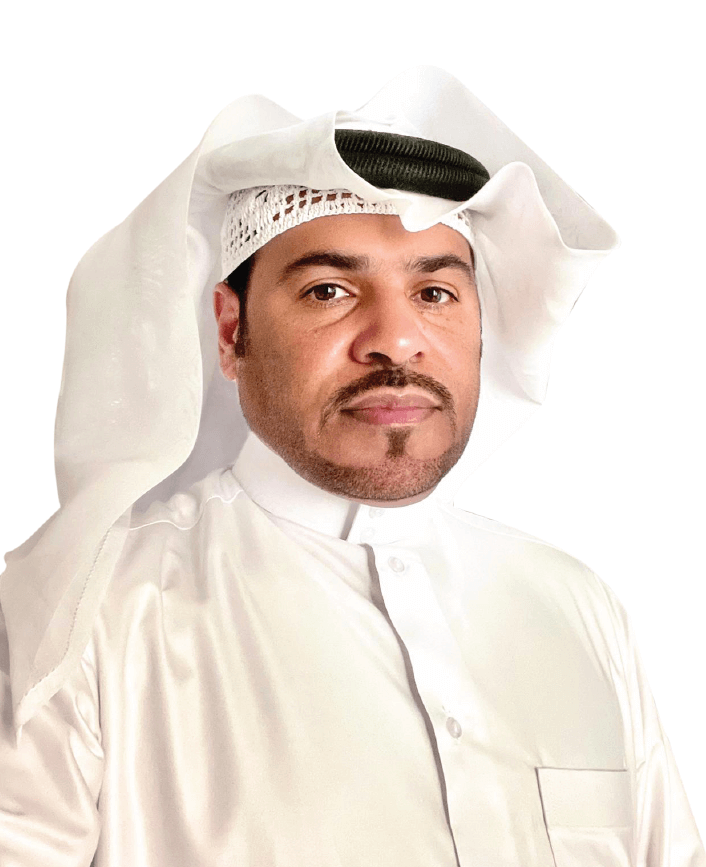Mohammad Al-Atiq: A Remarkable Career in Art
Mohammad Al-Atiq
A Remarkable Career in Art

“Art is like oxygen.”
With these words, Qatari artist Mohammed Al-Atiq began his conversation with us, answering what art means to him. This answer was no surprise, coming from one of the most prominent Qatari visual artists in recent decades. Al-Atiq’s work was showcased in the most distinguished art exhibitions worldwide and has won several awards from regional and international organizations.
In the following lines, we will become acquainted with this veteran artist’s path in the world of fine art. He will tell us about notable milestones in his career and the significance of art in our lives. He will also touch on the future of fine art in Qatar and share his advice with anyone desiring to follow in his footsteps.
Early Talent
The credit for discovering Mohammed Al-Atiq’s talent goes back to his schoolteachers. Being naturally talented and the encouragement and unlimited support of his family helped him to develop his abilities. over the years. He began to strive, research, and learn everything related to arts. Later, he took part in competitions and won them.
“I became convinced that my career should be in art, but I didn’t just want to be a painter. I wanted to be a full-fledged artist who could create his own works. It was a personal challenge for me as my father passed away while I was in school, and he was my biggest supporter. I wanted to fulfill my promise to him and become an artist who will raise the name of Qatar in the world”.
“I honed my skills by learning art in youth centers and through reading, traveling, visiting exhibitions and museums, joining art festivals, and attending seminars. I was keen to know everything new in the field of art and this enriched my knowledge and gave me a visual impetus through which I created my own art later”.
Turning to motion graphics and digital design programs, the ambitious young man established the Graphics Department at Qatar TV in 1991. This field was a new method for him to reach the audience through a different kind of art. Despite his success at Qatar TV, he never forgot his dream of becoming a global visual artist representing Qatar in international exhibitions, so he continued developing his artistic talent and setting up local exhibitions. About this time of his life, he says: “My graphics work in television entailed learning and acquiring considerable skills in digital design and motion graphics. This momentum in information, experiences, and highly technical knowledge contributed to my artistic work; it enabled me to apply the techniques and tricks that I learned to present a different kind of art to the audience”.
Atiq 99
Atiq 99 was the title of the exhibition held in 1999 in Al Bidda Park and constituted a real turning point in Al- Atiq’s career. In this exhibition, he displayed nearly 50 artworks that received a lot of praise from the public. Afterward, people began to know him as an expert artist who seeks to put his mark on Qatari visual art by presenting different art experiences.
Following years of hard work, the Qatari artist’s first international exhibition was held in Italy in 2002. He then participated in several international exhibitions, including the “Venice Biennale,” one of the most famous art exhibitions worldwide, culminating in many awards, the first of which was during the “Dhaka Biennale” in Bangladesh that had 1,500 artists from all over the world.
In addition to his work for Qatar TV, Al-Atiq chaired the Qatar Fine Arts Association from 2006 to 2013, during which he began a new assignment in managing Regency Art, a private non-profit organization that aims to support artists in the State of Qatar.
Over the past years, the organization has exerted great effort to attract and develop Qatari artists and educate the community about the meaning of art by organizing seminars and workshops that gather young artists from all over Qatar.
One of its most prominent achievements was the annual Al Asmakh International Art Symposium in Doha. This international art gathering brings together artists from all over the world in one place to work on their art and organize workshops and seminars, allowing them to learn about each other’s methods and experiences. The event represented a valuable opportunity for young artists in Qatar to benefit from the expertise of international artists without incurring the cost and trouble of traveling to similar events abroad.
Al Asmakh International Art Symposium was also world-renowned for providing exceptional facilities for artists to attend and participate from all over the world. It earned the “Best International Symposium” award from the Bassamat Association in Morocco. Al-Atiq was also awarded the “Ambassador of Peace and Culture” title from the Peace and Culture Bridges Organization in California, USA, thanks to his efforts as the general coordinator of the Al Asmakh International Art Symposium.
Al-Atiq believes that the private sector’s role in developing art is crucial. He maintains that fine art development in Qatar entails more art workshops, international lectures, seminars, and private sector initiatives that sponsor and support artists.
Despite the cancellation of this annual event and the suspension of other related activities due to COVID-19, the veteran artist is confident that conditions will improve in the future. He says: “Throughout history, artists have faced greater challenges and overcame them. I hope things return to normal quickly so that we organize exhibitions and workshops again, as art can play a major role in helping the society recover from the effects of this crisis”.

Art in Our Lives
The veteran artist believes that experiences, observations and readings are what make a visual artist as they accumulate in his mind until the time he extracts them in the form of an art project, such as a painting, sculpture, or other works.
He explains: “Visual art includes multiple and open channels and involves more than just drawing. Unlike the past, artists do not only succeed because they have the skill of drawing, but because they present a set of related ideas. Even the exhibitions have become contemporary and not traditional. Everything has changed”.
Al-Atiq adds that artists play an essential role in educating the public by presenting new and untraditional works that motivate them to be more insightful. His recent exhibition held in the “Fire Station” building last April, was entitled ‘Attention’. He used simple materials from waste in creating artworks that highlight the danger of waste to the environment and the earth’s future.
Al-Atiq believes that although some may not realize it, art is an essential part of life. He added: “Art is all around us. At home, there is the art of interior design, wall colors, and lighting. When you go out, you get into a car designed by an artist. When you look around, you see the streets, sidewalks, trees, gardens, buildings, all of which contain art touches. You can also see art in the design of your mobile phone and the apps you use”.
He concluded: “In short, we live in an artistic state from the moment we wake up till we go to bed, even if we don’t notice it. Imagine if everything I mentioned wasn’t there. We will surely become depressed”.
Al-Atiq hopes to create artwork that remains in the history of Qatar, so he is currently working on a stereoscopic project that seeks to achieve this goal. He also aspires to play a role in training future generations of local artists.
Promising Future
Al-Atiq predicts a bright future for fine art in Qatar thanks to the state’s interest in museums, art galleries, and organizations that encourage artists, such as Qatar Museums Authority as well as educational institutions, such as Virginia Commonwealth University School of the Arts in Qatar.
However, he maintains that the priority should be caring for young people, searching for talent in different regions, and developing them. He says: “I hope that art centers will return in different areas with some dedicated to girls. I learned art and graduated from one such center. There was a lot of interest in searching for talented people in schools, nurturing them, and providing them with all the amenities to harness their talent.”.
“Each center covered a specific geographical area, so children in Al Khor or Al Wakra did not need to travel a distance to come to Doha, and it was convenient for parents. We need to revive these centers and ensure that they keep up with the times and answer the needs of future generations. These centers should not be limited to teaching how to draw; they should also teach contemporary arts, such as sculpture, animation, graphic design, and other kinds of art needed now”.
The proficient artist also believes that educating children about the importance of art will build generations of Qatari artists from an early age. He explains: “Our children spend so much time playing video games, surfing the Internet, and browsing social media without a real purpose. We should introduce them to art at an early age and allow them to explore it. Children have a natural spirit of adventure, imagination, and the passion to try something new”.
“I remember meeting a successful young artist who told me that she started taking an interest in art when she attended Atiq 99 at the age of 12. I felt so happy and proud”.
Al-Atiq believes that the current generation’s opportunity to pursue an art career is considerably easier compared to what his generation faced in the old days. Remembering those days, he says: “They were beautiful days, although we did not have the luxury of technology and social media for people to know us. Materials are now more readily available. In the past, possibilities were limited; for example, we used to send CVs through fax, but now we can send a digital file containing all our information and work through a WhatsApp message!”.
He extends his advice to anyone who wants to pursue a career in visual art, saying: “First of all, you must develop a passion for art and love this profession from your heart because it is not easy. You will need to put a lot of effort as you will face challenges, and you also must set a goal for yourself. It is also important to continue the journey where other artists have finished and not start from scratch as this will save you many years of learning”.
